Day 6 of the “Ultimate Australian Rail Holiday” Monday 23rd May 2016
We are in for a big day of touring today, and the weather is still against us, but at least the coach picks us up on schedule at 7.30am. As a “reluctant retiree” that is a time you will usually find me still in my pyjamas, but today we are on a mission to explore the Margaret River region of Western Australia. For a reasonably simple map, click here.
It’s a straight run south on a well maintained highway, which at one point is shared by the commuter train to Mandurah running down the centre median strip! Mandurah is about an hour south of Perth, the second largest city in the state and increasingly popular with retirees. The next major township is Bunbury (third largest), and its satellite city, Australind. Both are on the coast, and Bunbury has a bulk export port, but agriculture is very important too, and we have been driving past green farmland dotted with grazing cattle.
We are now at one end of Geographe Bay, named in May 1801 by French explorer Nicolas Baudin. While the infant British colony was finding its feet on the other side of the country in New South Wales, Napoleon Bonaparte sent Nicolas Baudin in the Le Geographe, and Jacques Hamelin in the Le Naturaliste, off on an expedition to map the coast of New Holland, and we see frequent reminders of their endeavours in the place names of this area.
Around the same time, the Englishman Matthew Flinders was circumnavigating and mapping Australia, in a vessel called the Investigator. He and Baudin crossed paths in early 1802, and they exchanged information. Which was nice, considering their two countries were at war at the time – but maybe they didn’t get the memo.
Cape Leeuwin, our destination, was named by Flinders in honour of the Dutch ship of that name (the Lioness) which is reputed to have been the first to sail past and chart this area in 1622.
By now it is mid-morning and we reach our first stop for morning tea and a quick look around. Busselton, gateway to the Margaret River region, also boasts the longest timber jetty in the southern hemisphere.
Here is how it looks on a sunny day:
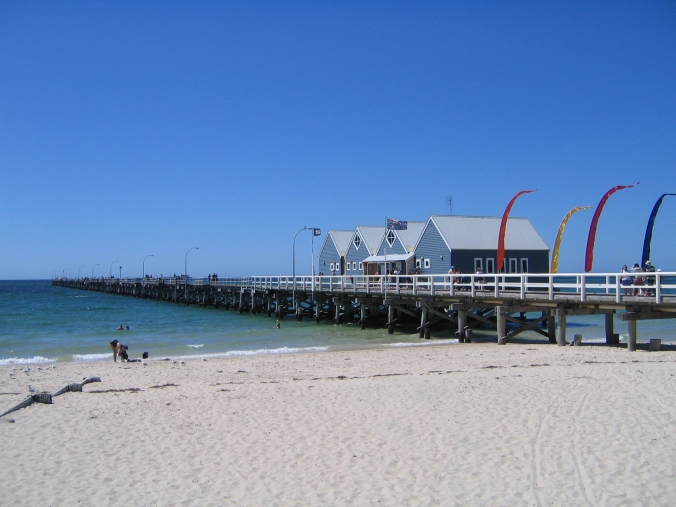
Busselton Jetty Western Australia. Photograph by Greg O’Beirne – Own work, CC BY 2.5, https://commons.wikimedia.org/w/index.php?curid=353364
And here is how we saw it:
I have a dozen other photographs that are even bleaker. We were happy to get back to the warmth of the coach, but we can still appreciate what a pretty area this would normally be. The beachfront is dotted with Norfolk Pine trees, the jetty stretches out for 1.8km (a bit over a mile), which you can either walk or ride by a miniature train, and there is an underwater observatory. There is even a bust of Baudin on the waterfront promenade 🙂 . Plus lots of other things to do in the town and surrounding areas.
We know the Margaret River region primarily for its food and wine, but it is also popular for beach holidays, hiking, camping, and limestone caves – which we visit after lunch.
But first! To the Bootleg Brewery – an oasis of beer in desert of wine – to sample their beers and ciders and have a lunch of a very filling sampling platter. . .
Followed by wine tasting at Sandalford Winery. They have a wine that I love for an “afternoon with cheese” sip, the Sandalford Element Late Harvest. It is sweet, as you would expect, but not cloyingly so like a botryitis or sauterne, and has lots of fruit aroma. So you can guess which was my preferred tasting. It’s not so easy to get in the Eastern States stores, but it can be ordered online.
Two tour guides were waiting for us when we reached Mammoth Cave, which is usually a self-guided visit. It was wonderful to be able to interact with them about what we were looking at, and how the caves were formed. It is home to ancient fossil remains of long-extinct giant marsupial animals. We last came across this with the Diprodoton at Wellington. In Mammoth Cave, we saw the 50,000 year old jawbone of its cousin, a Zygomaturus trilobus. Both look something like a modern day wombat, only much, much bigger.
Caves are great to look at, but hard to photograph! Who else was taught to differentiate stalagmites and stalactites by the rhyme, “the mites go up and the tights come down“?
Continuing south, heading for the Cape Leeuwin Lighthouse near Augusta, we drove through the Boranup Forest. Even though the rain was falling again, we could still appreciate its enormous Karri Trees. This is Australia’s tallest hardwood, Eucalyptus diversicolor, native to this area and capable of growing from 45 to 70 metres (145 to 230 feet).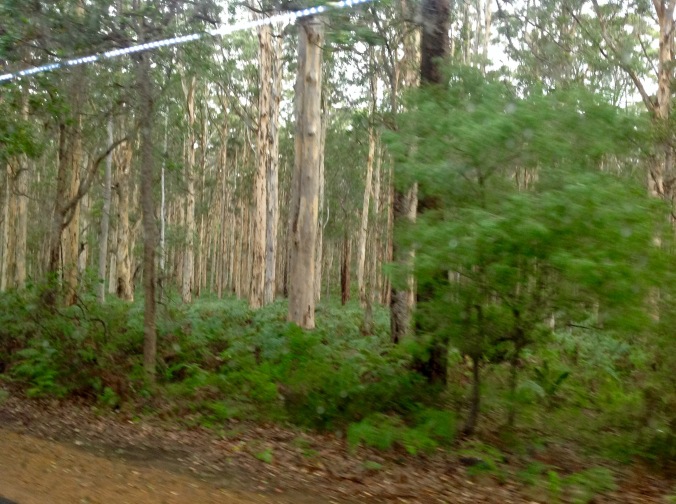
And then we reach the most south-westerly mainland point our continent, Cape Leeuwin, claimed to be the meeting of the Indian and Southern Oceans, and in case you are in any doubt: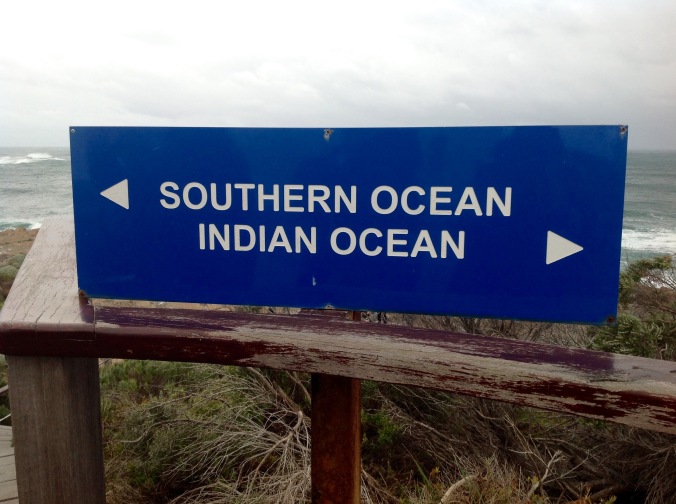
And this is what it looked and sounded like on this cool and windy autumn’s day:
And would you have wanted the job that saw you living in one of these lighthouse keeper’s cottages?
Tending to this lighthouse, built in 1895/6, comprising seven floors, 186 steps and originally lit with a kerosene wick lamp? It was totally manually operated until 1982 and automated ten years later (source: http://www.lighthouses.org.au).
And here’s a bit of fun. Back in March to June 2010, 85 cows were put out to pasture at various places in the Margaret River region. Then the bovines of the “Cow Parade” were auctioned for charity. “Moorine Marauder” now lives at the Cape Leeuwin Lighthouse, keeping out a sharp eye for potential shipwrecks.
Turning north, we headed back into the pretty township called Margaret River. Some people were leaving the tour here, to stay in the region for a few days. Which is a good idea, as there is plenty to see in the area and the town itself has lots of craft and art stores. It was coming on dark as we strolled around the main streets.
Still in the Margaret River region, but headed in the direction of Perth, we drove through a small town called Cowaramup. Perhaps inspired by Cow Parade, and as a play on the name of their town, around 40 fibreglass cows have been installed throughout, outside businesses, in the street, on the road verges. The black and white Friesians represent the dairy herds of the area. We could just spot them as we glided past in the gathering darkness.
A half hour or so later we were back in Busselton, where some more of our company left the tour, while the rest of us went for dinner at the Abbey Beach Resort who had been phoned ahead with our meal orders. So we were well fed and “watered” for our two and half hour drive back to Perth and the various hotel drop-offs. All up, it was about a fourteen hour tour. A long day for us – and even longer for our brilliant driver/guide. All the same, a great taste-tester. Having seen the area, we know we could stay for much longer next time.
For Reference: We booked our tour through the Australian Holiday Centre.
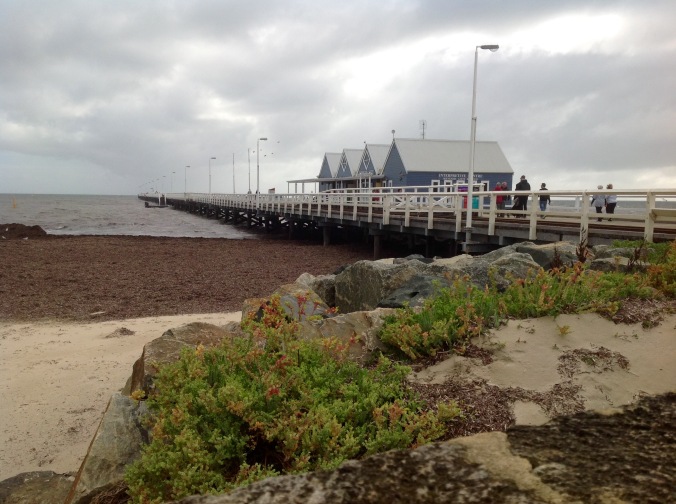












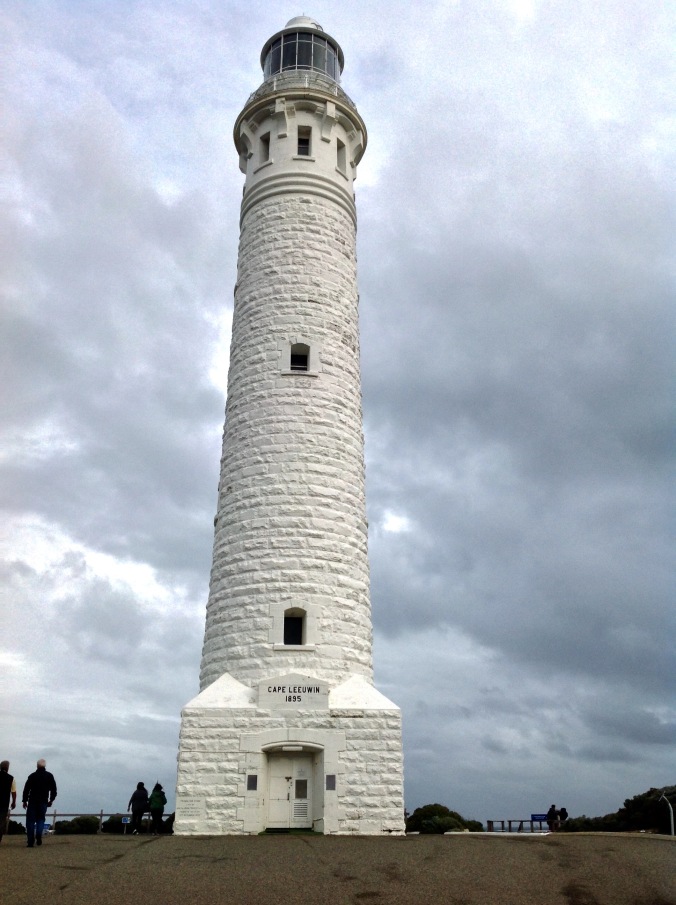
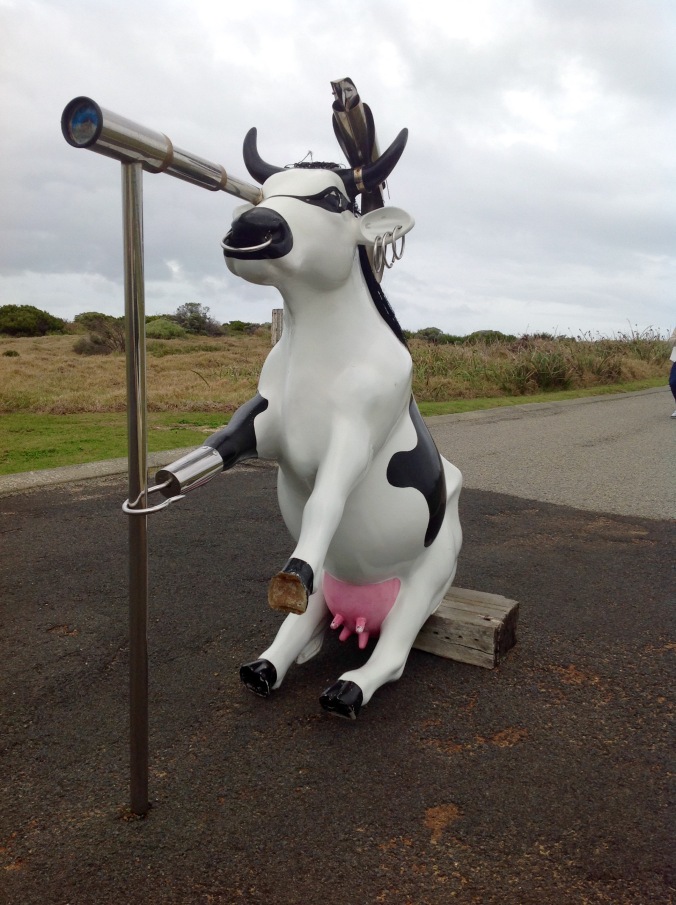
We did a similar one day tour a few years ago. One day we will get back to explore more thoroughly.
LikeLiked by 1 person
Post COVID we may need our passports to enter Western Australia 🙂
LikeLike
Pingback: Adelaide to Robe SA – Day 11 of Road Trip March 2020 | The Reluctant Retiree
Finally I’m catching up with the blog-reading (and writing) again. Lovely trip, as always you make me want to go travel 🙂
LikeLike
I am taking so long to finish the story of this trip. If I can’t find spare time to write them, I can only praise you that you find the time to read them! xxxx Gwen
LikeLiked by 1 person
I was once bar manager of the pub at Waroona (just up a bit from Bunbury), and I used to go up to Perth and back on the old train, “The Australind”, was a great ride, they had a bar on the train so no guessing in which car I rode.
Glad you did some wine tasting at Margaret River, some of Oz’s best wine comes from that region as you know;
LikeLiked by 1 person
I recalled you had mentioned the Australind train, and I was thinking of you as we saw the modern version. Oh where, oh where has all the romance gone? I drink quite a bit of Margaret River wine. Oh wait! I drink quite a bit of wine. Fullstop.
LikeLike
Ah yes – what a difference blue skies make!!!!! Honestly and truthfully I can report that we do have blue skies in the East of England at the moment – probably as I’ve just ordered a summer waterproof mac. Photographing caves, yes it’s very difficult for a non-professional. I didn’t know where to start and haven’t managed as good as yours. I don’t think even the professionals really capture that ‘enclosed, yet awesome’ atmosphere you experience in caves big or small. Caves smell different and you can almost feel the air can’t you?
LikeLike
A friend posted a “missing” notice on Facebook a few days ago – referring to the sun in Kent, so I got the impression summer wasn’t quite living up to expectations. Meantime, I was enticed into a shop the other day on account of some attractive boots – only to discover they were fabulous “wellies”. Where would I ever wear them? No wonder they were on special. I have only been using the iPad on my travels, so I didn’t expect great photographic results, although the flowers of Kings Park look very vibrant. Doesn’t seem to be translating to the blog posts, but I am viewing them on the laptop, which I think is getting a bit old. The caves were very interesting. They didn’t have too much of a dank smell, as you don’t need to go into the Mammoth Cave very far before you start seeing the formations. But they are certainly enclosed. There is a kind of vibration of silence on your ears. I found my notes after I had worked several hours on the last post. The tiny chocolate wattled bat (about the size of a moth) lives inside, and there is evidence that Aboriginals used them as an overnight stopping place. One photo I did not post looks like an elephant’s trunk, and is actually a tree root – grown through the roof of the cave then ossilised, or whatever is the correct term for being covered in limestone drippings. I think you would have to utilise a tripod and time lapse camera to get any shot that captured what the eye can see.
LikeLike
I think the photos from the iPad are pretty amazing considering the size and convenience of using it, but I think you’re about the time lapse idea. Still, where would tourism be if we could get the same experiences by staying at home!!!
LikeLiked by 1 person
Oh Lordy! Look at those skies! It was cold (for Aussies), windy, with scattered showers – which mostly fell when we were on the coach, thank goodness. Not in the script at all. I’ve just been looking at the next day’s photos. Look forward to the return of the sun 🙂
LikeLike
Another excellent tour. I think your bleak photos are better than the sunny one
LikeLiked by 1 person